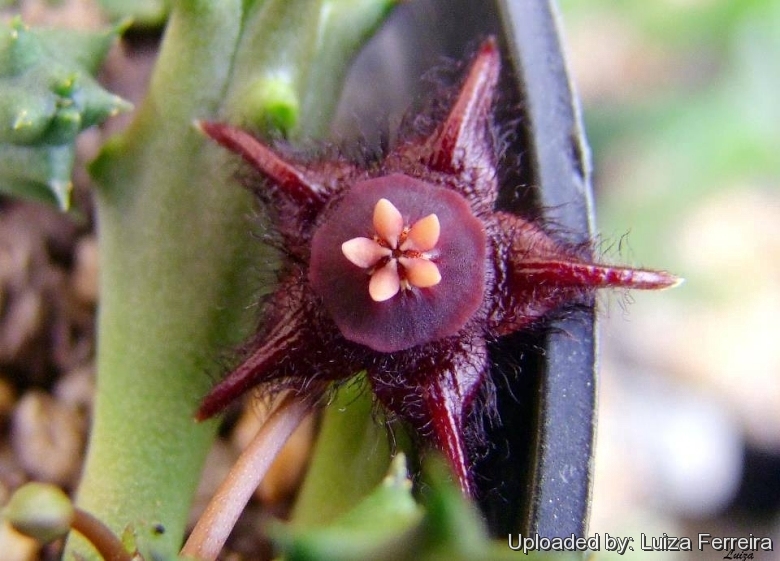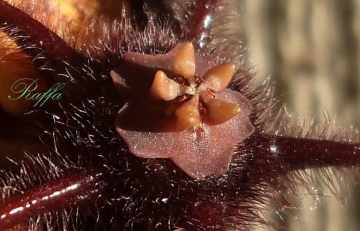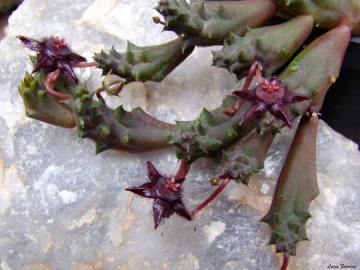




Your support is critical to our success.

Origin and Habitat: Robertson to Riversdale, Western Cape, South Africa. Extent of occurrence 1400 km², in about 10 known locations.
Habitat and Ecology: Renosterveld on shale. Agriculture is a severe past and ongoing threat as the species is lost to wheat, vines, deciduous fruits, pasture and olive farming. Livestock farming (such as ostrich and horse) in the Bonnievale and Robertson areas are also a threat.
Synonyms:
- Duvalia elegans (Masson) Haw.
- Stapelia elegans Masson
Duvalia elegans (Masson) Haw.
Syn. Pl. Succ. 44 1812
Synonymy: 7
- Duvalia elegans (Masson) Haw.
- Stapelia elegans Masson
- Duvalia elegans f. magnicorona A.C.White & B.Sloane
- Duvalia elegans var. seminuda N.E.Br.
- Duvalia jacquiniana (Schult.) Sweet
- Stapelia jacquiniana Schult.
- Stapelia radiata Jacq.
ENGLISH: Elegant Duvalia
Description: Duvalia elegansSN|30350]]SN|30350]], the "elegant duvalia," differs from the other species by its heavy coat of long purple hairs on the flat and seldom reflexed corolla tips; sometimes in var. seminuda N.E. Br. these are glabrous in the apical region. The flowers open two or three together from the base of the stems. They are up to 2 cm across, purplish brown to dark purple with a rufescent pentagonal bottom. D. elegans is the type species of the genus.
Stems: Decumbent and ascending, sometimes descending under the ground, ovoid to cylindrical, 18-45(-60) mm long, 8-12(-18) mm thick, oblong, with 4–5 obtuse tuberculate-denticulate angles, glabrous, dull green or purplish-tinted.
Roots: Fibrous.
Leaves: Rudiments 1-1.5 mm stipular glands minute, rarely absent.
Flowers: 2–3 together near the base of the stems procumbent, with foetid odour, developing successively. Pedicels 10-25 mm long, glabrous. Sepals 2-3 mm long, 1 mm wide, lanceolate, acute, glabrous. Corolla 12-22 mm in diameter, rather flat, very dark purple-brown, shining, pilose all over the inner face with rather long soft purple hairs 2-3 mm long, glabrous on the back. Hairs simple, 1-3 mm long, purple more or less curved. Corolla-lobes 5-10 mm long, 3-6 mm broad at the base, ovate or deltoid-ovate, acute or shortly acuminate, flattish at the basal part, slightly replicate towards the apex. Annulus not very evident, scarcely raised above the level of the fold of the lobes circular, 6 - 8 mm in diameter, 0.8-1.5 mm high, pubescen. Outer corona reddish-brown to purple, disc 5-7 mm in diameter, almost covering the annulus, nearly circular, obscurely pentagonal or rarely shortly 5-lobed, nearly flat, dark red-brown. Inner corona-lobes pale brownish-yellow 1.2 - 1.8 x 1.2 - 1.6 mm. Pollinia 0.28 - 0.34 x 0.2 mm.
Blooming season: July September.
Fruits: Seed pods (follicles), usually appearing as twin horns up to a year after flowering, 8- 13 cm, fusiform, terete, apically acute, but not beaked, wingless, smooth, decorative.
Seeds: 5 x 3 mm.
Bibliography: Major references and further lectures:
1) George Don “A General System of Gardening and Botany” Volume 4 Rivington, 1838
2) N. E. Brown “Flora Capensis” Vol 4, page 518, 1909
3) Bruyns, P.V. “Stapeliads of southern Africa and Madagascar” (Vol. 1, pp. 1-330). Umdaus Press, Pretoria. 2005
4) Helme, N.A. & Raimondo, D. 2007. “Duvalia elegans (Masson) Haw.” National Assessment: Red List of South African Plants version 2014.1. Accessed on 2015/01/25
5) Focke Albers, Ulrich Meve “Illustrated Handbook of Succulent Plants: Asclepiadaceae: Asclepiadaceae” Volume 4 Springer, 2002
6) Ulrich Meve, Focke Albers “The species concept in Duvalia (Asclepiadaceae): A preliminary revision of the genus” In: Mitteilungen aus dem Institut für Allgemeine Botanik in Hamburg. 23: 595–604.1990.
7) Werner Rauh “The Wonderful World of Succulents: Cultivation and Description of Selected Succulent Plants Other Than Cacti” Smithsonian Institution Press, 1984
8) Bruyns, P. V. 2005. "Stapeliads of Southern Africa and Madagascar", vol. 1: 68-81.
9) Meve, U. 1997. "The genus Duvalia (Stapelieae)", 130 pp, Springer, Wien.
10) Margaret J. Martin, Peter Richard Chapman “Succulents and their cultivation” Scribner, 1978

Duvalia elegans Photo by: Raffa C. Garcia

Duvalia elegans Photo by: Luiza Ferreira

Duvalia elegans Photo by: Luiza Ferreira
The gallery now contains thousands of pictures, however it is possible to do even more. We are, of course, seeking photos of species not yet shown in the gallery but not only that, we are also looking for better pictures than those already present. Read More...
Cultivation and Propagation: Duvalia alegans is an easy obliging blooming plant when mature, that it is happy in any average succulent house.
Potting:Since roots are quite shallow, use a soft and incoherent cactus mix or add extra perlite or pumice to regular soil potting soil, and clay pots help the plants to dry out between watering.
Waterings: Duvalia require moderately watering through the growing season but enjoy plenty of water and some fertiliser in hot weather, this helps them to flower freely. Water more sparingly in winter according to temperatures. But, as with most asclepiads, it is unwise to leave them wet in cold weather.
Fertilization: Fertilizers for succulent plants must be rich in potassium, but poor in nitrogen, to avoid the plants from developing excess vegetation, which is easily attacked by fungal diseases.
Sun Exposure: As with many succulents, they prefer to grow in the light shade of scrubby shrubs or between rocks where they get some shade during the day. In summer it is advisable to position this plant in a partially shady place, where it is exposed to direct sunlight only during the coolest hours of the day.
Hardiness: These plants don't like cold weather, therefore in the Spring it is best to set them outside only when the temperatures are above 15°C. Can endure temperatures below 5°C for short period, but only if the soil stays completely dry.
Pest and diseases: Duvalia species vary in their susceptibility to rotting, but are generally fairly easy to grow, especially if kept pest-free. They are very susceptible to stem and root mealy bugs, and damage from these may well initiate fungal attack. If you do have problems with a stem or with basal rotting, you can reliably isolate the healthy parts, dry them off, and re-root them in moist compost.
Cultural Practices: Re-pot every 2 years.
Propagation: Easiest with stem cuttings. Allow cuttings to dry a day before planting. Stems must be laid (Not buried) on gritty compost and will then root from the underside of the stems. It can also be increased from seeds sowing in spring in moist, sandy peat moss. Barely cover seeds. Seeds germinate quickly.
| Your Actions | |
|---|---|
| Back to Duvalia index | |
| Back to Asclepiadaceae index | |
 |
Back to Succulents Encyclopedia index |
Privacy stantement - Terms and conditions - How to cite - About us - Feedback - Donate




